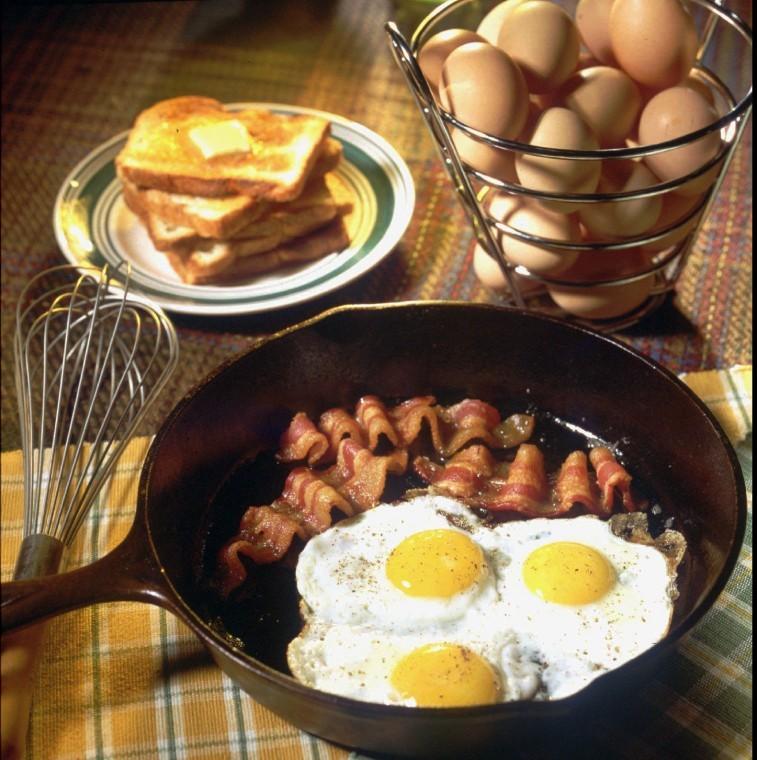Start your day with a protein-rich breakfast
One serving of Canadian bacon contains eight grams of protein and one egg contains six grams of protein.
September 19, 2012
Feeling hungry and thinking about food can be very distracting when you’re trying to concentrate in class.
According to a study by the University of Kansas Medical Center, skipping breakfast increases brain activity associated with hunger and cravings prior to lunchtime. Eating a breakfast high in protein helps stave off hunger throughout the morning, leading to better concentration and less food-related brain activity.
Protein is rich in amino acids, which are important for brain function. Waking up and having a protein- rich breakfast supports alertness and provides a good foundation to learn at a full mental capacity.
In order to suppress your appetite and feel full longer throughout the morning, you should eat 35 to 40 grams of protein for breakfast. This amount may seem difficult to consume in one meal, but here are a few ideas to start off with.
Plan ahead and buy fresh ingredients on a weekly basis and create a menu. It will allow you to consciously plan a variety of options each day rather than resorting to the same foods.
Eggs are the most obvious choice and can be eaten any style. Boiled eggs are the most convenient to take on the road but must be eaten soon after cooking to prevent spoiling. One egg contains six grams of protein, most of which is in the white.
Eggs can also be combined with cheese, veggies and meat to make a scramble or omelet for added nutritional benefit and added protein. Mushrooms, tomatoes, onions, spinach and broccoli are a good source of vitamins and antioxidants and are also great to incorporate in a high protein meal.
Most breakfast meat, such as lean sausage and Canadian bacon and most cheeses, contain at least eight grams of protein per serving. Combining meat, eggs and cheese with whole or refried beans to make a breakfast burrito is another creative way to pack in the protein.
One whole grain tortilla consists of four to seven grams of protein – depending on the size – and beans are also a great source of protein and fiber. One cup of black beans has 15 grams of protein and pinto beans are right behind them with 14 grams of protein per cup. Peanut butter and almond butter are great sources of protein containing seven to eight grams per serving and can be spread on a variety of different breads. They work great on whole grain toast or bagels and smashed together with fresh jam. One slice of whole wheat bread or a one medium- sized bagel has about nine grams of protein.
Dairy is extra special because it can be made into a cold, sweet treat and makes a great high-protein option. The calcium and vitamin D in dairy are ideal for optimal bone health.
Greek yogurt, which can be bought in a variety of flavors, has 13 grams of protein and just one cup of cow’s milk has ten. Milk and yogurt can be used to create smoothies and protein shakes, which are easy and convenient ways to drink your breakfast on the go. Blend one scoop of any flavor protein powder with fruits and veggies for an ultimate balanced meal.
Oatmeal, which can be boring, has five grams of protein per cup. Make it more interesting and increase the protein by adding nuts and using milk instead of water – which will also make it creamier. Use any fruit, honey, maple or agave syrup as natural sweeteners. One ounce of walnuts or almonds has six grams of protein.
Wheat germ is a secret weapon and can be sprinkled on pretty much anything. One fourth of a cup of wheat germ contains 6.5 grams of protein. Add it to shakes and yogurt or sprinkle it on oatmeal or cereal. Wheat germ is removed from the whole grain and has a nutty, slightly bitter taste when raw and a richer taste when toasted.
Gina Cruz can be reached at [email protected]








































































































































